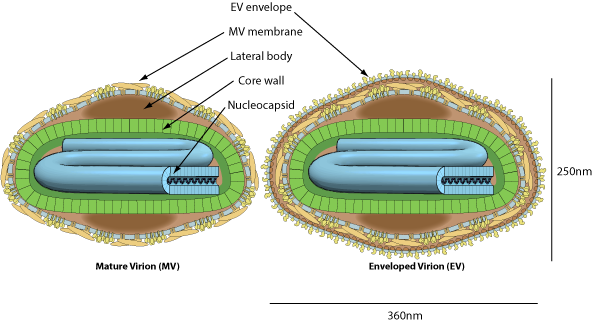VIRION

Enveloped, brick-shaped virion, 250nm long and 200nm wide. The surface membrane displays surface tubules or surface filaments. Two distinct infectious virus particles exists: the intracellular mature virus (IMV) and the extracellular enveloped virus (EEV).
GENOME
Linear, dsDNA genome of 170-250kb. The linear genome is flanked by inverted terminal repeat (ITR) sequences which form covalently closed hairpin termini at each extremity.
GENE EXPRESSION
ENZYMES
- DNA-directed DNA polymerase [E9L (OPG071)]
- DNA-directed RNA polymerase [E4L (OPG066)]
- Cell-type capping
- RNA TPase [D1R (OPG113)]
- GTase [D1R (OPG113)]
- N7MTase [D1R (OPG113) + D12L (OPG124)]
- 2'O methylase [J3R (OPG102)]
- Core protease (Peptidase C57) [I7 (OPG083)]
- Metalloprotease (Peptidase M44) [G1L (OPG085)]
- Phospholipase [F13 (OPG057)]
REPLICATION
CYTOPLASMIC
- Attachement of the viral proteins to host glycosaminoglycans (GAGs) mediates endocytosis of the virus into the host cell. The virus can be uptaked also by apoptotic mimicry
- Fusion with the plasma membrane to release the core into the host cytoplasm.
- Early phase: early genes are transcribed in the cytoplasm by viral RNA polymerase. Early expression begins at 30 minutes post-infection.
- Core is completely uncoated as early expression ends, viral genome is now free in the cytoplasm.
- Intermediate phase: Intermediate genes are expressed, triggering genomic DNA replication at approximately 100 minutes post-infection.
- Late phase: Late genes are expressed from 140 min to 48 hours post-infection, producing all structural proteins.
- Assembly of progeny virions starts in cytoplasmic viral factories, producing an spherical immature particle. This virus particle matures into brick-shaped intracellular mature virion (IMV).
- IMV virion can be released upon cell lysis, or can acquire a second double membrane from trans-Golgi and bud as external enveloped virion (EEV).


